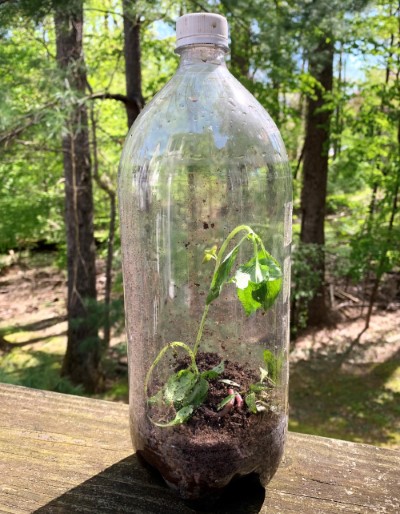Earth Science Week Classroom Activities
Wetland in a Water Bottle
Activity Source:
U.S. Geological Survey. Adapted with permission.
Wetlands are places where the water table is usually at or near the surface or the land is covered by water or saturated at least some of the time. They include mangroves, marshes, swamps, forested wetlands, and bogs and are important nurseries for young birds, fish, amphibians, and other aquatic plants and animals. In addition to providing habitat for wildlife, wetlands offer storm protection, improve water quality, support aquatic species, and provide recreational opportunities.
USGS wetland scientists provide scientific information that can allow managers and decision makers to anticipate the possible changes to wetlands due to climate change such as rising sea levels and/or changes in precipitation patterns, and other human impacts.

Example of a wetland in a water bottle.
Credit: A. Scott/USGS
Materials
- Clean, empty 2-liter bottle (recycled soda/water bottles work well)
- Measuring cup
- Funnel
- 1 cup of small rocks
- ¼ cup water
- 1 cup of soil
- Leaves, twigs, or other organic matter
- Small plant with roots attached (ex. bean sprouts, herbs, etc.)
- Twig or stick that is longer than the bottle
- One or two worms
Procedure
1. Remove the bottle cap and use a funnel to slowly add the materials to the bottle in this order:
- 1 cup small rocks
- ¼ cup water
- 1 cup soil
- Leaves, twigs, or other organic material
- Small plant with roots (use the twig or stick to help push the roots into the soil)
- Worm/s
2. Secure the cap to the bottle and place the bottle where there is sunlight or artificial light.
3. You have made a miniature wetland! This self-contained, closed system supports plant and animal life. Observe your mini wetland over time, at least a week. What do you notice? Take pictures or notes to record these changes.
4. How do you think the plants and animals (worm/s) survive without air holes in the bottle?
5. Research the water cycle. What parts of the water cycle do you observe in your mini wetland?
6. Research what plants and animals need to survive. Does that help to answer your question to step 4?
Wetland in North Carolina.
Credit: Debra Willard/USGS
Source
Extensions
- If you were to make a larger wetland in an aquarium or plastic bin, what else could you add? Why?
- Is there a wetland near your home or school? If so, visit the wetland and describe what you see with an adult in your life.
- Learn about Wetland Ecologists with the “I Am A…” careers in science video series and coloring pages at https://www.usgs.gov/media/videos/i-am-awetland-ecologist
NGSS Connections
Science and Engineering Practices – Developing and Using Models
Disciplinary Core Ideas – Earth’s Materials and Systems, Interdependent Relationships in Ecosystems, Cycles of Matter and Energy in Ecosystems
Crosscutting Concepts – Systems and System Models; Scale, Proportion, and Quantity
SDG Connections
- 13: Climate Action
- 14: Life Below Water
- 15: Life on Land
